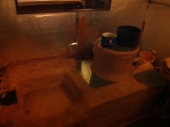




“Action on behalf of life transforms. Because the relationship between self and the world is reciprocal, it is not a question of first getting enlightened or saved and then acting. As we work to heal the earth, the earth heals us.” ~ Robin Wall Kimmerer




out in the garden





out in the garden









“Action on behalf of life transforms. Because the relationship between self and the world is reciprocal, it is not a question of first getting enlightened or saved and then acting. As we work to heal the earth, the earth heals us.” ~ Robin Wall Kimmerer




Heather Olivia wrote:Thank you, Sue! Yes, I agree this is certainly non-ideal and can see why tile makes sense in this context. That is our plan for the other half of the house. Perhaps I should have mentioned the choice of wood floor is not merely an aesthetic one. We noticed that in the winter, the slab got super cold and it was not feasible to do yoga on, which is something we really need. Also, in the warm times, because the slab is cooler and we don't have central air, we get condensation on the slab. We have already had mold issues and seeing as we have lots of wood furniture, I'd be concerned it would become a mold farm with that stuff on a sweating tile floor. So we decided that insulating this part of the floor was the way to go, even though I don't love the materials. I can live with most of it, just not sure about the plywood.
I wish we had known about that sealer! That sounds like a great solution. How much odor was there while it dried? Unfortunately, I don't think we could use that now without moving out for several days and we have too many other obligations presently to handle that right now.
out in the garden


|
Normally trees don't drive trucks. Does this tiny ad have a license?
Play Your Way to a Sustainable Lifestyle: Uncover Permaculture Principles with Each Card
https://gardener-gift.com/
|



